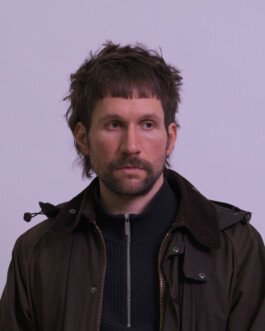*1991, Frankfurt am Main
Education
2015
Studies at the University of Art and Design, Offenbach am Main
2024
Diploma with Prof. Martin Liebscher and Prof. Dr. Juliane Rebentisch

Contact: mail@dennishaustein.com
Dennis Haustein's work positions itself as a form of aesthetic research, driving the discourse on contemporary understandings of nature. His photographic installations explore the interconnections between humans and non-human beings, as well as their modes of existence. At the heart of his work lies an examination of the intersections between nature, culture, and technology, which he perceives as an interwoven, hybrid, and fragile whole. His large-scale installations evoke a sensitivity for a precarious nature and its entanglements, underscoring the connections of which we are all a part.
Solo Exhibitions
2022/23
Compilation
Kunst- und Kulturstiftung Opelvillen, Rüsselsheim
Exhibitions
2024
some lives on earth
Graduation Show, Zollamt Galerie, Offenbach am Main
Soft Proof
RAY Triennale der Fotografie, Museum angewandte Kunst, Frankfurt am Main
Junge Kunst mit Zukunft
Nacht der Museen, Museum angewandte Kunst, Frankfurt am Main
Trace Evidence
f/stop 10. Festival für Fotografie Leipzig, Galerie Potemka, Leipzig
2022
Of Second Glances
Magma Maria, Offenbach am Main
Fotografie ÷ Malerei
Zollamt, Offenbach am Main
Was bleibt ist der Bodensatz
Zollamt, Offenbach am Main
2021
Frankfurter Kunstvertrieb
Magma Maria x Frankfurter Kunstverein, Frankfurt am Main
2019
Fail Early and Often - Martin Liebscher & Students
SAP, Walldorf
2018
irrational longing
10. Darmstädter Tage der Fotografie, Darmstadt
Comment ai-je pu me perdre?
Goethe Institut, Paris
The Biography of Things
Deutsche Börse Photography Foundation, Frankfurt am Main
2017
Bitte ein Liebscher
Neue Galerie, Haus Beda, Bitburg
irrational longing
Expo Real Estate, München
Wirkungsraum
CLB Berlin, Berlin
Awards
2019
Deutsche Börse Photography Foundation und HFG Fotoförderpreis
Scholarships
2024
Jahresstipendium Künstlerhilfe Frankfurt e.V.
2022
HAB Film- und Medienförderung Abschlussförderung (für Diplom-Nebenfach „Compilation“)
2021
„Create“ Künstlerhilfe Frankfurt e.V.
2020
Deutschlandstipendium
Projektstipendium „hessen innovativ neu eröffnen“ – Hessische Kulturstiftung
Collections
SAP Kunstsammlung
Publications
2024
SOFT PROOF – RAY - Triennale der Fotografie 2024,
Anton Kusters, Tatiana Vdovenko, Frankfurt am Main
2021
Was bleibt, ist der Bodensatz – Ausstellungskatalog,
Martin Liebscher, Offenbach am Main
2019
Fail early and often – Alexandra Cozgarea, Martin Liebscher,
Offenbach am Main,
ISBN 978-3-00-062769-9
2018
Perspektiven - Strategien fotografischen Handelns –
10. Darmstädter Tage der Fotografie, Darmstadt,
ISBN: 978-3-9813629-9-2
The Biography of Things – Deutsche Börse Photography
Foundation, Goethe Uni. Frankfurt, HfG-Offenbach,
ISBN: 978-3-00-058714-6
2017
wirkungsraum – Ausstellungskatalog, Berlin
*1991, Frankfurt am Main
Education
2015
Studies at the University of Art and Design, Offenbach am Main
2024
Diploma with Prof. Martin Liebscher and Prof. Dr. Juliane Rebentisch

Dennis Haustein's work positions itself as a form of aesthetic research, driving the discourse on contemporary understandings of nature. His photographic installations explore the interconnections between humans and non-human beings, as well as their modes of existence. At the heart of his work lies an examination of the intersections between nature, culture, and technology, which he perceives as an interwoven, hybrid, and fragile whole. His large-scale installations evoke a sensitivity for a precarious nature and its entanglements, underscoring the connections of which we are all a part.
Solo Exhibitions
2022/23
Compilation
Kunst- und Kulturstiftung Opelvillen, Rüsselsheim
Exhibitions
2024
some lives on earth
Graduation Show, Zollamt Galerie, Offenbach am Main
Soft Proof
RAY Triennale der Fotografie, Museum angewandte Kunst, Frankfurt am Main
Junge Kunst mit Zukunft
Nacht der Museen, Museum angewandte Kunst, Frankfurt am Main
Trace Evidence
f/stop 10. Festival für Fotografie Leipzig, Galerie Potemka, Leipzig
2022
Of Second Glances
Magma Maria, Offenbach am Main
Fotografie ÷ Malerei
Zollamt, Offenbach am Main
Was bleibt ist der Bodensatz
Zollamt, Offenbach am Main
2021
Frankfurter Kunstvertrieb
Magma Maria x Frankfurter Kunstverein, Frankfurt am Main
2019
Fail Early and Often - Martin Liebscher & Students
SAP, Walldorf
2018
irrational longing
10. Darmstädter Tage der Fotografie, Darmstadt
Comment ai-je pu me perdre?
Goethe Institut, Paris
The Biography of Things
Deutsche Börse Photography Foundation, Frankfurt am Main
2017
Bitte ein Liebscher
Neue Galerie, Haus Beda, Bitburg
irrational longing
Expo Real Estate, München
Wirkungsraum
CLB Berlin, Berlin
Awards
2019
Deutsche Börse Photography Foundation und HFG Fotoförderpreis
Scholarships
2024
Jahresstipendium Künstlerhilfe Frankfurt e.V.
2022
HAB Film- und Medienförderung Abschlussförderung (für Diplom-Nebenfach „Compilation“)
2021
„Create“ Künstlerhilfe Frankfurt e.V.
2020
Deutschlandstipendium
Projektstipendium „hessen innovativ neu eröffnen“ – Hessische Kulturstiftung
Collections
SAP Kunstsammlung
Publications
2024
SOFT PROOF – RAY - Triennale der Fotografie 2024, Anton Kusters, Tatiana Vdovenko, Frankfurt am Main
2021
Was bleibt, ist der Bodensatz – Ausstellungskatalog, Martin Liebscher, Offenbach am Main
2019
Fail early and often – Alexandra Cozgarea, Martin Liebscher,
Offenbach am Main,
ISBN 978-3-00-062769-9
2018
Perspektiven - Strategien fotografischen Handelns –
10. Darmstädter Tage der Fotografie, Darmstadt,
ISBN: 978-3-9813629-9-2
The Biography of Things – Deutsche Börse Photography
Foundation, Goethe Uni. Frankfurt, HfG-Offenbach,
ISBN: 978-3-00-058714-6
2017
wirkungsraum – Ausstellungskatalog, Berlin
Contact